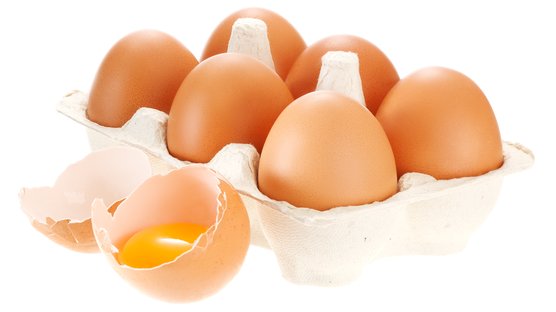
Published on Sept. 19, 2023
Eggshell color Eggsplained
The eggshell color in chickens is not just nature's artistic ability; it is a fascinating mix of biological processes influenced by a range of factors, including genetics, diet, and environmental conditions. The wide spectrum of eggshell colors, including brown, white, tinted, blue, green, and dark brown (as seen in Marans), adds diversity to the world of poultry. In this article we have tried to explain how laying hens can produce all these different colored eggs.
Aspects of eggshell color formation
The primary factors contributing to eggshell coloration are pigments, genetics, diet, and environmental conditions. Pigments such as porphyrins and biliverdin play pivotal roles in painting the eggshells with various shades, from rich browns to delicate blues. The genetics of a chicken play a significant role in determining eggshell color. Genetic traits inherited from both roosters (sire) and hens (dam) determine the type and intensity of pigments, leading to distinct eggshell colors among different breeds. Below an overview of the different colors that we are selecting our laying hen populations for:
- White Eggs: Chickens with a specific genetic trait lay white eggs. They lack the ability to deposit pigments in the eggshell, resulting in a white appearance. The most common white egg layer breed is the Leghorn chicken.
- Brown Eggs: Chickens that produce brown eggs have genes that enable them to deposit varying amounts of porphyrins in the eggshell. This pigment produces the characteristic brown color. Breeds like the Rhode Island Red, Sussex and the Barnevelder are known for laying brown eggs.
- Green and Blue Eggs: Certain breeds, such as Araucanas, the Old Cotswold Legbar, the Azur, and the Olive, carry a genetic variation that allows for the deposition of biliverdin, resulting in blue and green eggshells. The intensity of the color may vary among individuals and breeds. There is still limited knowledge around the synthesis of biliverdin in chickens, it is most likely synthesized in the shell gland itself and then deposited onto the eggshell.
- Tinted eggs: These are the result of the cross breeds of chickens that lay white eggs and brown eggs. Good example of chicken breeds laying tinted eggs are the ISABELL, ISA Tinted or ISA Grey, which are the result of crossing Rhode Island Reds with White Leghorn.
- Dark Brown Eggs: Marans chickens, a French breed, are famous for their exceptionally dark brown eggs. The intense brown color of the eggs is due to the deposition of a high concentration of porphyrins in the eggshell. Selective breeding has led to the development of new breeds of laying hens, like the Noirans and English Burford Browns, that produce darker shades of brown eggs with every new generation.
- Black eggs: Unfortunately black eggs do not (yet) exist to our knowledge. There is confusion that eggs laid by Ayam Cemani chickens are a dark, almost iridescent black color, but in fact eggs laid by Ayam Cemani chickens are tinted in color.
Additionally, the chicken’s diet could affect the eggshell color. It is atypical, but a deficit in nutrients can impact eggshell development. The administration of certain drugs such as nicarbazin will result in pale eggs. Environmental stressors can alter the coloration of the eggshell, for instance, the presence of predators. The reason for this is that the pigment is transferred to the egg four hours before it is laid, if the egg is laid earlier, then there might not be enough pigment deposited. If eggs are kept longer in the oviduct due to stress, then a layer of calcium might be deposited and give the egg a white-grey exterior. Exposure to sunlight can also leave their mark on the eggshells' appearance. The reason is not precisely known but an explanation could be the increase in vitamin D3 production due to sunlight exposure and the combination with the one in the ration which results in an overdose of vitamin D3. Some diseases and parasite infestation will damage the oviduct and has negative effects on the eggshell color.

Formation of the eggshell: The process
The process of eggshell formation unfolds within the hen's reproductive system, specifically in the oviduct, where the shell is meticulously built layer by layer. Pigments, porphyrins and biliverdin are introduced into the equation during the final stages of shell formation, determining the eggshell's color. This complex biological interaction results in the wide group of eggshell colors seen in various chicken breeds.
The process, known as oogenesis, involves several stages:
- Follicular Development: Begins in the ovary with thousands of follicles, one of which matures into the egg.
- Ovulation: The matured egg is released into the infundibulum.
- Fertilization (Optional): Fertilization can happen in the infundibulum before shell formation.
- Albumen Formation: In the magnum, egg white is added to the egg.
- Eggshell Membrane Formation: In the isthmus, inner and outer membranes develop.
- Pigment Deposition: In the shell gland (uterus), pigments like porphyrins and biliverdin are deposited, with color influenced by genetics.
- Calcium Deposition: Calcium carbonate crystals form the outermost eggshell layer.
- Shell Formation: Eggshell membranes, pigments, and calcium carbonate combine to form distinct layers.
- Shell Calcification and Hardening: Over 18 to 24 hours in the shell gland, the eggshell hardens.
- Egg Laying: Once fully formed, the hen lays the egg.
The pigment deposition stage in the shell gland determines eggshell color, genetics, diet, and environment can influence the intensity of eggshell coloration and quality.
Eggshell Pigmentation and the Genetic Mechanisms Behind Varied Colors in Chicken Eggs
Chicken eggs come in various shell colors, such as brown, white, tint, blue, or green. The predominant eggshell colours, brown and white, result from long-term selective breeding of todays laying hens. However, there is an increasing demand seen for blue-shelled eggs in many regions around the globe (niche markets). The majority of the pure lines behind these specialty egg colors have not undergone the same extensive breeding for egg color uniformity, egg laying persistency and overall egg quality. As a result, more variation in egg shell color can be found, like in the example of the olives, they range from light green, to intensive dark green, but also eggs with a more brown undertone can be found.
Eggshell colors can be distinguished visually, or by measuring L* (lightness), a* (redness), and b* (yellowness) values using a colorimeter. Alternatively, specific instruments like high-performance liquid chromatography can directly detect eggshell pigments. These pigments primarily include protoporphyrin-IX, biliverdin, and zinc chelates of biliverdin. Protoporphyrin-IX is found in brown eggs, while biliverdin is in blue-green eggs
Eggshell pigmentation occurs through a series of enzymatic reactions. Protoporphyrin-IX is produced from glycine and later converted to biliverdin. Once the egg reaches the part of the reproductive tract called the uterus or shell gland, this will stay there for about 20 hours. Throughout this time, calcium carbonate is deposited on top of the shell membrane that wraps the albumen and yolk, forming the eggshell. As the process continues, the epithelial cells lining the surface of the shell gland begin to produce and accumulate the pigments, in the case of brown eggs, mostly Protoporphyrin-IX . The majority of the stored pigment is not transported to the cuticle (protein-rich, viscus-fluid secretion) until the last 3 to 4 hours of shell production. The amount of pigment that is directly linked to the cuticle determines how brown the hen's eggshell will be. Around 90 minutes (about 1 and a half hours) before oviposition, when shell deposition hits a plateau, the pigment-rich cuticle is laid down on the eggshell. As a result, pigment distribution is not even across the eggshell's thickness. While the eggshell does contain some pigment, compared to the cuticle, it contributes very little to the brown color's intensity.
Genes like ALAS1, SLCO1B3, HMOX1, and ABCG2 play crucial roles in this process. An avian retrovirus element, EAV-HP, is integrated into SLCO1B3, leading to higher expression in blue-shell-laying hens. However, other genes like ABCG2 and HMOX1 may also regulate the eggshell color, particularly in different blue-shell variants.
Poor pigmentation in brown-shelled eggs.
Factors causing poor eggshell pigmentation in colored eggs are complex and not attributed to a single factor. While some people might assume infectious bronchitis as the primary cause, this is often speculative without proper evidence like antibody titers or vaccination schedules. Stressors, rather than diseases, are frequently responsible for pigment loss. Identifying the exact cause of pigment loss can be challenging, and in many cases, it remains unidentified.
- Lack of a Single Cause: There is not a single factor responsible for pigment loss in brown-shelled eggs. Broiler breeders often exhibit more varied pigmentation than commercial layers due to different breeding priorities.
- Misattribution to Infectious Bronchitis: Many mistakenly attribute pale eggshells solely to infectious bronchitis without proper evidence, such as antibody titers or necropsy findings.
- Stress as a Common Factor: Stressors like high cage density, handling, or loud noises can lead to the release of stress hormones, especially epinephrine, disrupting the formation of the eggshell cuticle and resulting in pale eggshells.
- Age of the Bird: As brown egg-type birds age, eggshell pigment intensity may decrease. The exact cause is unknown but may be due to pigment dispersion or reduced synthesis.
- Chemotherapeutic Agents: Certain drugs, like sulphonamides and Nicarbazin, can cause a rapid decline in egg shell pigmentation, even leading to complete depigmentation when given at higher doses.
- Disease: Viral diseases such as Newcastle and infectious bronchitis can affect egg production and lead to thinner, abnormally pale, and irregularly shaped eggshells with watery whites.
Most eggshell pigments are concentrated in the cuticle and the outer part of the calcified eggshell. Factors like stress, age, chemotherapeutic agents, and disease can affect pigment intensity. These complexities highlight the importance of not prematurely diagnosing infectious bronchitis as the sole cause of pigment loss. However, IB affects body tissues, and each portion of the reproductive tract can be affected. If chickens are infected in early life, the IB virus may cause permanent damage to the oviduct. After 2 to 5 days of exposure to the virus, pale eggs can appear, and the occurrence can continue for various weeks. Understanding these multifaceted factors is fundamental for poultry professionals, enabling them to selectively breed chickens to produce a wide range of eggshell colors that cater to consumer preferences.
Earlobe in the prediction of eggshell color
The color of a chicken's earlobes can provide insights into the color of the eggs it will lay. Generally, hens with white earlobes tend to produce white eggs, while those with colored feathers and darker earlobes are more likely to lay colored eggs. This correlation holds true for most commercial chicken breeds. However, exceptions exist among ornamental backyard breeds. Earlobe color in chickens is influenced by numerous factors, including genetics, ancestral lineage, mutations, and adaptation to local conditions. For instance, white earlobes are associated with the deposition of purine bases, while other colors may result from a mixture of pigments like melanin or carotenoids. Interestingly, the degree of redness in an earlobe may reflect the bird's health.
Recent research has shed light on the genetic basis of earlobe color, revealing that the white/red earlobe trait is polygenic and sex-linked in certain chicken populations. However, there is no direct genetic link between earlobe color and eggshell color. These traits involve different sets of genes located on separate chromosomes. The common belief that red-earlobed hens lay brown eggs and white-earlobed hens lay white eggs is based more on historical breed characteristics than on a direct genetic correlation. This relationship between the earlobe and eggshell color primarily applies to commercial breeds and was established over a century ago. In summary, while earlobe color can provide clues about egg color in many cases, it is not an absolute rule, and exceptions exist, particularly among ornamental chicken breeds.
To conclude
The formation of eggshell color in chickens is a multifaceted process influenced by genetics, diet, and environmental factors. Understanding the genetic basis and the mechanisms behind the deposition of pigments in the eggshell is essential for poultry breeders, scientists, and egg industry professionals. By selecting and breeding chickens with desired color traits, it is possible to produce a wide range of eggshell colors to meet consumer preferences all over the globe.
References
- Agrimprove. (n.d.). 8 factors of eggshell color. Retrieved September 18, 2023, from https://www.agrimprove.com/8-factors-of-eggshell-color/
- Bradley, F. A., & King, A. J. (2016). Egg Basics for the Consumer: Packaging, Storage, and Nutritional Information (Vol. 8154). University of California, Agriculture and Natural Resources. https://doi.org/10.3733/ucanr.8154
- Butcher, G. D., & Miles, R. D. (n.d.). Factors Causing Poor Pigmentation of Brown-Shelled Eggs 1. http://edis.ifas.ufl.edu.
- Chris Lesley. (2021, April 6). Salmon Faverolle: Breed Information, Care Guide, Egg Color and More. https://www.chickensandmore.com/salmon-faverolle/#:~:text=Salmon%20Faverolles%20were%20first%20bred,Flemish%20Cuckoo%2C%20Malines%20and%20Dorking.
- Gary D. Butcher, & Richard D. Miles. (2018, March 7). FACTORS CAUSING POOR PIGMENTATION OF BROWN-SHELLED EGGS. https://edis.ifas.ufl.edu/publication/VM047
- Lu, M.-Y., Xu, L., Qi, G.-H., Zhang, H.-J., Qiu, K., Wang, J., & Wu, S.-G. (2021). Mechanisms associated with the depigmentation of brown eggshells: a review. Poultry Science, 100(8), 101273. https://doi.org/10.1016/j.psj.2021.101273
- Paul Schattenberg. (2022, April 11). Why are eggs different colors? https://agrilifetoday.tamu.edu/2022/04/11/why-are-eggs-different-colors/
- Piet Simons. (2017). Egg Signals. Roodbont Publishers B.V.
- Samiullah, S., Roberts, J. R., & Chousalkar, K. (2015). Eggshell color in brown-egg laying hens — a review. Poultry Science, 94(10), 2566–2575. https://doi.org/10.3382/ps/pev202
- University of Florida. (2019, February 20). INFECTIOUS BRONCHITIS AND ITS EFFECT ON EGG PRODUCTION AND EGG QUALITY. https://edis.ifas.ufl.edu/publication/VM014
- Wang, H., Ge, Y., Zhang, L., Wei, Y., Li, Q., Zhang, X., & Pan, Y. (2023). The pigments in eggshell with different colour and the pigment regulatory gene expression in corresponding chicken’s shell gland. Animal, 17(5), 100776. https://doi.org/10.1016/j.animal.2023.100776



